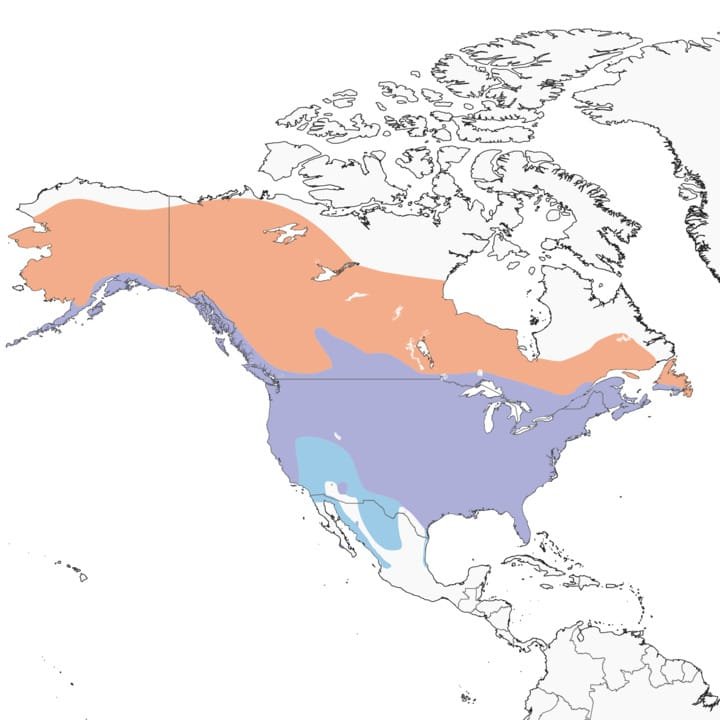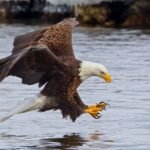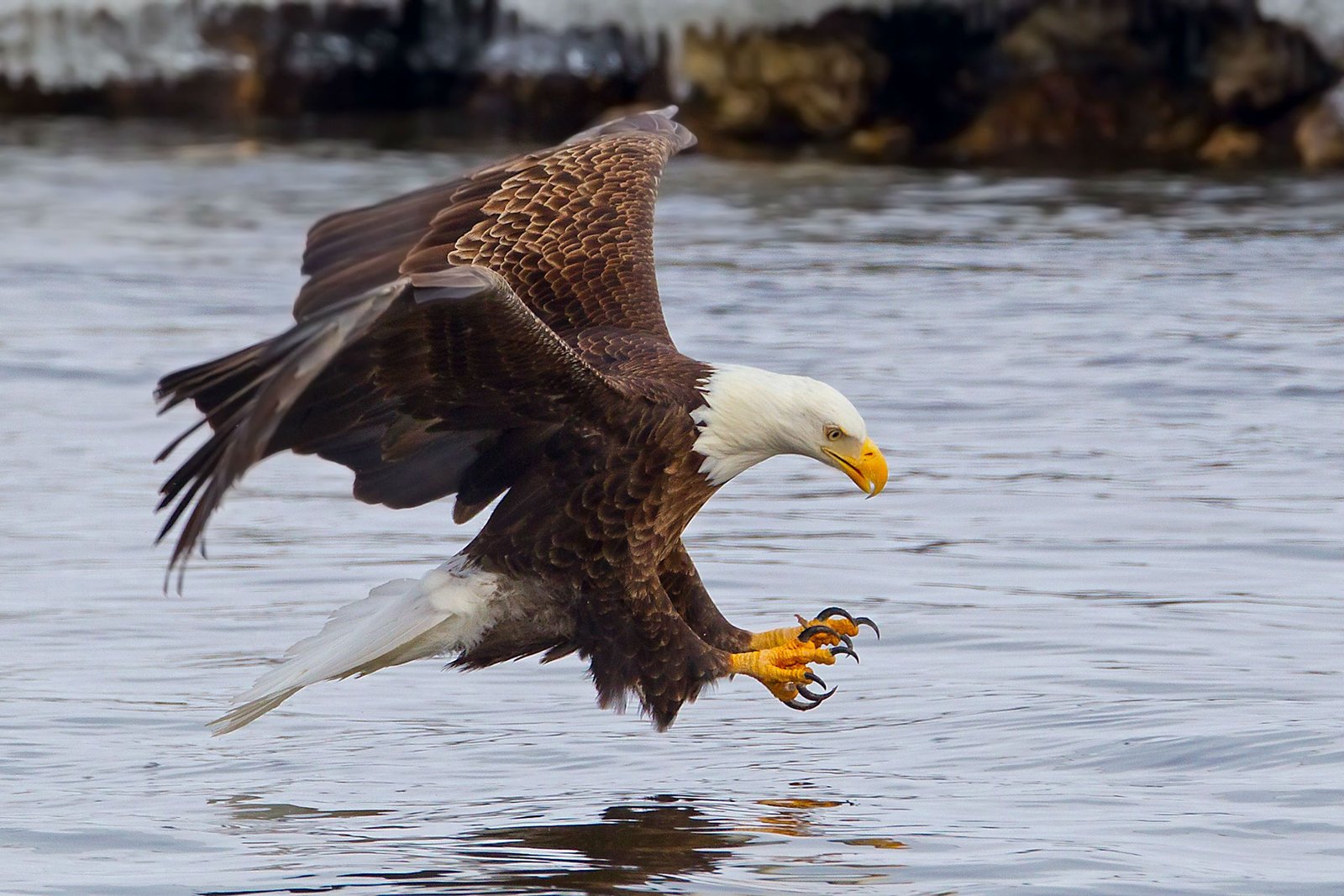The bald eagle (Haliaeetus leucocephalus) is a bird of prey found in North America. A sea eagle, it has two known subspecies and forms a species pair with the white-tailed eagle (Haliaeetus albicilla), which occupies the same niche as the bald eagle in the Palearctic. Its range includes most of Canada and Alaska, all of the contiguous United States, and northern Mexico. It is found near large bodies of open water with an abundant food supply and old-growth trees for nesting.
The bald eagle is an opportunistic feeder which subsists mainly on fish, which it swoops down upon and snatches from the water with its talons. It builds the largest nest of any North American bird and the largest tree nests ever recorded for any animal species, up to 4 m (13 ft) deep, 2.5 m (8.2 ft) wide, and 1 metric ton (1.1 short tons) in weight. Sexual maturity is attained at the age of four to five years.
Distribution
Geography
- Continents : North America, Europe, Asia
- Subcontinents : Caribbean Islands, Central America
- Countries : Canada, Mexico, United States
The bald eagle has a body length of 70–102 cm (28–40 in). Typical wingspan is between 1.8 and 2.3 m (5 ft 11 in and 7 ft 7 in) and mass is normally between 3 and 6.3 kg (6.6 and 13.9 lb).Females are about 25% larger than males, averaging as much as 5.6 kg (12 lb), and against the males’ average weight of 4.1 kg (9.0 lb).

Habits and Lifestyle

The plumage of an adult bald eagle is evenly dark brown with a white head and tail. The tail is moderately long and slightly wedge-shaped. Males and females are identical in plumage coloration, but sexual dimorphism is evident in the species, in that females are 25% larger than males. The beak, feet and irises are bright yellow. The legs are feather-free, and the toes are short and powerful with large talons. The highly developed talon of the hind toe is used to pierce the vital areas of prey while it is held immobile by the front toes.The beak is large and hooked, with a yellow cere. The adult bald eagle is unmistakable in its native range. The closely related African fish eagle (Haliaeetus vocifer) (from far outside the bald eagle’s range) also has a brown body (albeit of somewhat more rufous hue), white head and tail, but differs from the bald eagle in having a white chest and black tip to the bill











CreatBot D600 Pro 2 Industrial 3D Printer is a state-of-the-art 3D printing device designed for businesses demanding accuracy, reliability, and versatility in 3D printing devices. As part of the D600 series, it incorporates a spacious build volume, advanced dual extruder technology, and high-performance features suitable for industrial use and varied materials.
CreatBot D600 Series Overview
The CreatBot D600 Series and D600 Pro models establish benchmarks for large-scale 3D printers solutions. With a build volume of 600 ? 600 ? 600 mm, these professional large format 3D printers cater to a wide range of industrial 3D printing demands, from large model prototyping to end-use production. The D600 Pro lineup and the latest D600 Pro 2 introduce further improvements in performance and material compatibility.
Key Features and Advantages
Large Industrial Build Volume
Build size: 600 ? 600 ? 600 mm
Ideal for large format 3D printing projects and industrial 3D printing
Supports technical materials and complex prototypes
Dual Extruder System and High-Temperature Printing
4th generation dual 1.75mm extruders for multi-material printing
Right and left-side extruder design for flexible printing process
Supports high performance 3D materials, including PLA, nylon, carbon-fiber, and more
Maximum nozzle temperature: up to 420°C (high-heat)
Heated build chamber for high-performance applications
Accuracy, Speed & Dependability
Professional 3d print quality with accurate layer resolution
Advanced motion system for high-speed printing and robust performance
Consistent printing speed up to 120 mm/s
Reliable operation for continuous industrial use
Supported Materials and Filaments
Broad Filament Support
Works with a broad spectrum of filament: PLA, ABS, PC, PETG, PVA, nylon filament, carbon-fiber, and more
Designed for engineering-grade materials and functional prototyping
Advanced dual extruder 3d printer enables multi-material and soluble support printing
Uses: Prototyping & Manufacturing
The CreatBot D600 Pro 2 model and D600 Pro 3D printer serve a diverse set of applications:
Rapid prototyping and large format 3D print models
Functional parts for automotive, aerospace, and engineering
Tooling, jigs, and fixtures for industrial production
Art, architecture, and creative projects requiring large-scale industrial 3d printing
Specs
Model: CreatBot D600 Pro 2, D600 Pro, D600
Build volume: 600 ? 600 ? 600 mm
Extruders: Dual extruder, 4th generation 1.75mm dual extruders and hotends
Max nozzle temperature: 420°C
Heated bed: up to 100°C
Filament size: 1.75 mm
Layer resolution: 0.05 – 0.3 mm
Supported materials: PLA, ABS, PC, PETG, PVA, nylon, carbon fiber, engineering-grade materials
Print speed: up to 120 mm/s
Chamber: Heated, for improved material properties
Interface: Touchscreen interface
File formats: STL, OBJ, AMF
Comparing D600 Models
Feature Differences
D600 model: Entry-level industrial large scale 3d printer for basic applications
D600 Pro model: Enhanced with heated chamber, auto bed leveling, and wider material support
D600 Pro 2 (pro version): Adds higher print speed, improved reliability, and HS (high speed) configuration
Other CreatBot Models
CreatBot D1000 HS for even larger build volumes
CreatBot 3D printer includes industrial and professional 3d printer solutions
FAQ
Compatible Materials for CreatBot D600 Pro 2
The D600 Pro 2 is compatible with a wide range of filament types including PLA, ABS, PETG, PC, nylon, carbon fiber, and other engineering-grade materials.
Maximum Build Volume of D600 Pro 2
The printing volume is 600 ? 600 ? 600 mm, supporting large model and industrial 3d printing needs.
Does the D600 Pro 2 support dual extruder and high-temperature printing?
Yes, it is equipped with dual extrusion technology and reaches up to 420°C for high-temperature printing process.
What differentiates the D600 Pro 2 from the D600 Pro?
The Pro Version offers higher print speed, improved reliability, and the new HS (high speed) option.
Summary
The D600 Pro 2 and the D600 Pro set the benchmark in the industrial 3D printer category. With exceptional build volume, robust dual extruders and hotends, compatibility with engineering-grade materials, and high performance across applications, they empower businesses and engineers to achieve new heights in industrial 3D print.
creatbot d600 pro 3d printer
creatbot d600 pro
industrial 3d
large-scale industrial 3d